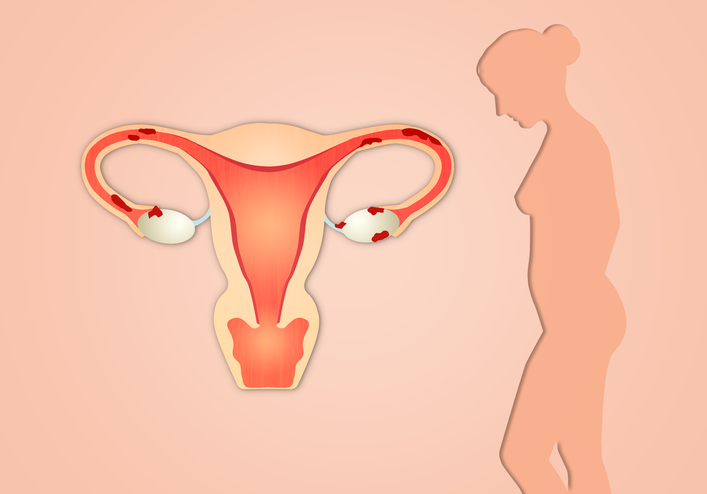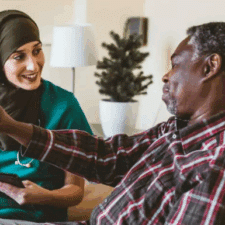
We share tips about what to wear, who to date, etc, but when it comes to health, many life-saving tips go unnoticed. Here, we take time to try and shed more light on a relatively still unexplained condition, endometriosis, not be confused with endometrial cancer. Here is the difference:
While pelvic pain is a symptom of endometrial cancer, it is also one of the main symptoms of a health condition called endometriosis, which very rarely leads to endometrial cancer.
What Is Endometriosis?
When a woman gets her period once a month, the lining of the uterus (which is called the endometrium) breaks down and is shed as menstrual flow. When a woman has endometriosis, the type of tissue that makes up the lining of the uterus also shows up in other parts of her body, including the ovaries, the fallopian tubes, the bowels, and the bladder. During her period, this tissue breaks down. But since it's outside the uterus, it can't leave the body during menstruation, and cysts and scar tissue may form as a result.
In even more rare cases, endometriosis has been found inside the vagina, inside the bladder, on the skin, even in the lung, spine, and brain.
In addition to causing pain that can become quite severe, endometriosis can also cause scar tissue and adhesions to develop that can distort a woman’s internal anatomy. In advanced stages, internal organs may fuse, causing a condition known as a "frozen pelvis." It is also estimated that 30-40% of women with endometriosis may become infertile.
Currently, endometriosis affects over five million women in the United States.
What Is Endometrial Cancer?
The abnormal tissue implants that grow as a result of endometriosis aren't cancerous. They're simply benign tissues that grow in areas where they aren't meant to grow. Endometriosis very rarely causes endometrial cancer or uterine cancer, as these cancers are seen in fewer than 1 percent of all women with endometriosis. In the rare instances where endometrial cancer does develop, it's typically found in older women — often post-menopausal — and the prognosis is generally pretty positive.
When associated with any type of uterine cancer, endometriosis most commonly (but still very rarely) is found with a type called endometrioid cancer — however, research hasn't shown that endometriosis causes this type of cancer.
Even though endometriosis rarely leads to endometrial cancer, these benign growths can still cause serious problems and pain.
Each month, a woman's body releases hormones that signal the start of the menstrual period, when the endometrium sheds its lining. With endometriosis, even though those tissues aren't inside the uterus, the abnormally growing endometrial tissues tend to get larger with the blood and endometrial tissue that is shed during the period.
As these tissues grow, inflammation and scar tissue can result, inhibiting the function of the fallopian tubes and the ovaries. Consequently, infertility is a common complication of endometriosis. Endometrial implants can also cause bladder and intestinal problems.
What Are The Causes of Endometriosis?
Most researchers, however, agree that endometriosis is exacerbated by estrogen. Subsequently, most of the current treatments for endometriosis attempt to temper estrogen production in a woman's body to relieve her of symptoms. At the moment there are no treatments, which fully cure endometriosis.
Several different hypotheses have been put forward as to what causes endometriosis. Unfortunately, none of these theories have ever been entirely proven, nor do they fully explain all the mechanisms associated with the development of the disease. Thus, the cause of endometriosis remains unknown. Several theories have become more accepted, and the reality is that it may be a combination of factors, which make some women develop endometriosis.
Genetic Predispostion. Studies have shown that first-degree relatives of women with this disease are more likely to develop endometriosis. And when there is a hereditary link, the disease tends to be worse in the next generation. An ongoing worldwide study called the International Endogene Study is conducting research based on the blood samples from sisters with endometriosis in hopes of isolating an endometriosis gene.
Lymphatic or Vascular Distribution. Endometrial fragments may travel through blood vessels or the lymphatic system to other parts of the body. This may explain how endometriosis ends up in distant sites, such as the lung, brain, skin, or eye.
Immune System Dysfunction. Some women with endometriosis appear to display certain immunologic defects or dysfunctions. Whether this is a cause or effect of the disease remains unknown.
Environmental Influences. Some studies have pointed to environmental factors as contributors to the development of endometriosis, specifically related to the way toxins in the environment affect the reproductive hormones and immune system response, though this theory has not been proven and remains controversial.
What Are The Symptoms?
The most common symptom of endometriosis is pelvic pain. The pain often correlates to the menstrual cycle, however, a woman with endometriosis may also experience pain at other times during her monthly cycle. For many women, but not everyone, the pain of endometriosis can unfortunately be so severe and debilitating that it impacts her life in significant ways.
Pain may be felt:
• Before/during/after menstruation
• During ovulation
• In the bowel during menstruation
• When passing urine
• During or after sexual intercourse
• In the lower back region
Other symptoms may include:
• Diarrhea or constipation
• Abdominal bloating
• Heavy or irregular bleeding
• Fatigue
Diagnosis
If you are experiencing symptoms like those of endometriosis, it is important that you talk to your clinician. Only a clinician can diagnose endometriosis. Sometimes a surgical procedure called laparoscopy is performed to diagnose endometriosis. During the procedure, a clinician looks inside a woman's pelvic cavity with special instruments to see if she has endometriosis. Some women can manage their pain with over-the-counter painkillers (such as ibuprofen), and some turn to changes in diet and exercise to deal with the symptoms. Unfortunately, the pain may be too severe for other women, in which case prescription treatments may be used.
There is no simple test that can be used to diagnose endometriosis, which may be why there is a diagnostic delay of up to 12 years in some healthcare settings.
At present the only reliable way to definitively diagnose endometriosis is by performing a laparoscopy and taking a biopsy of the tissue.
Diagnosing endometriosis is a challenge, but an experienced gynecologist should be able to recognize symptoms suggestive of endometriosis by talking with the woman and obtaining a history of her symptoms. For this to be effective, be honest with your physician about all of her symptoms and the pattern of these.
Treatment
Since the cause of endometriosis remains unknown, a treatment that fully cures endometriosis has yet to be developed, and there is no overwhelming medical evidence to support one specific type of treatment for endometriosis over another.
Choosing a treatment therefore comes down to the individual woman's needs, depending on her symptoms, her age, and her fertility wishes. She should discuss these with her physician so that they, together, can determine which long-term, holistic, treatment plan is best for her individual needs.
For many women, this can be a combination of more than one treatment over longer periods, including:
• Pain killers
• Hormonal Therapy
• Surgery
• Nutritional Therapy
• Alternative Medicine
Finally, remember that endometriosis affects more than just the physical body. It may affect women and girls in profound emotional ways as well. Psychologists and counselors can play an important role by helping women and girls cope with the feelings of confusion, disbelief, chronic pain, infertility, and frustration that often accompany this disease.
What Else Could It Be?
Other disorders can cause pelvic pain, including sexually transmitted infections, pelvic inflammatory disease (PID), and fibroids. Symptoms of endometriosis are similar to symptoms for these disorders.
Each month, track your pain and how heavy your flow is and how many days your period lasts. You'll discover whether or not your menstrual cycle is regular and how often you experience pain during your cycle. This will be helpful when talking to your clinician about whether or not your monthly pain might be something more than just a pain.
Severe menstrual pain shouldn't be ignored, so visit your clinician if you're experiencing any pain before or during your period, or pain during intercourse if you're sexually active.








